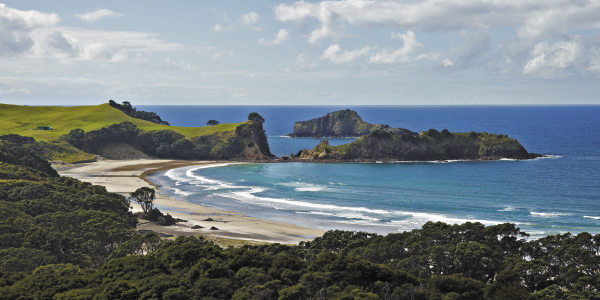Wrong for Mahurangi but right for Aotea – Great Barrier

Up There: A national park named Aotea on the doorstep of the largest metropolitan area of Aotearoa would be right up there with the Abel Tasman National Park, ‘down’ there. image Andris Apse
Ron was wrong about two important Mahurangi issues. At the time he wrote Jade River : A History of the Mahurangi, Dr Ronald Locker dismissed sedimentation as a serious threat to the health of the harbour, despite Dr Thomas Frank Wyndham Harris having published The Mahurangi System in 1993, just as Locker was in the dying stages of writing his hymn to the harbour.
Generally every bit the stickler for the scientific method, Dr Locker must be excused for his sedimentation blind spot on a number of levels. Firstly, the landscape of the harbour, after the deforestation of the latter half of the 1800s, looked largely healed.
Secondly, like many lovers of the Mahurangi harbourscape, he was reluctant to see it as other than pristine in its fortuitous escape from coastal urban development. Protection of the landscape was Dr Locker’s primary mission.
Finally, after he had completed the manuscript of his history of the Mahurangi and was writing its forward, Dr Locker was literally dying, of an inoperable cancer of the prostate. An enduring vision for his wife Sue was of the author sitting in the sunshine cradling a copy of the manuscript, which had been hastily bound for him, on his blanket-covered knees just days before his death.
The second major point about which Dr Locker was wrong, except in an ideal world, was regarding an appropriate instrument for protecting the harbour. Locker was a keen an accomplished mountaineer and fervent believer in the national parks system. But he challenged the assumption that only mountains were deserving of such status, and advocated, in Seacoast in the Seventies: The future of the New Zealand Shoreline, which he jointly authored with John E Morton and David A Thom, that the harbour and its environs become the Mahurangi National Park. Meantime, in the less than ideal world of regional planning that Frederick William Osborn Jones and Arnold Reay Turner were working, plans were being made for an instrument that, in less than fifty years has resulted in the protection of not only the critically at risk parts of the Mahurangi Harbour, but of a total of 26 regional parks protecting land and coastline that, were it contiguous, would be larger than some of the national parks of Aotearoa.
An Aotea National Park, however, is not wrong—the Parliamentary Commissioner for the Environment, Dr Jan Wright, has identified Great Barrier Island, or Aotea, as stewardship land that has high conservation value, yet low protection. The Royal Forest and Bird Protection Society of New Zealand, or Forest & Bird, is objecting to the Department of Conservation proposal to re-designate the publicly-owned stewardship land on Great Barrier Island as conservation park on the basis that land deserves the higher level of protection afforded by national park status.
Incredibly, the deadline for submissions is the same as that for Auckland Council’s proposed Unitary Plan: 5pm on Friday. Forest & Bird, however, have made it incredibly easy to send its suggested submission online—those with more time are encouraged to write their own.
Time for a change, and for a new national park!
